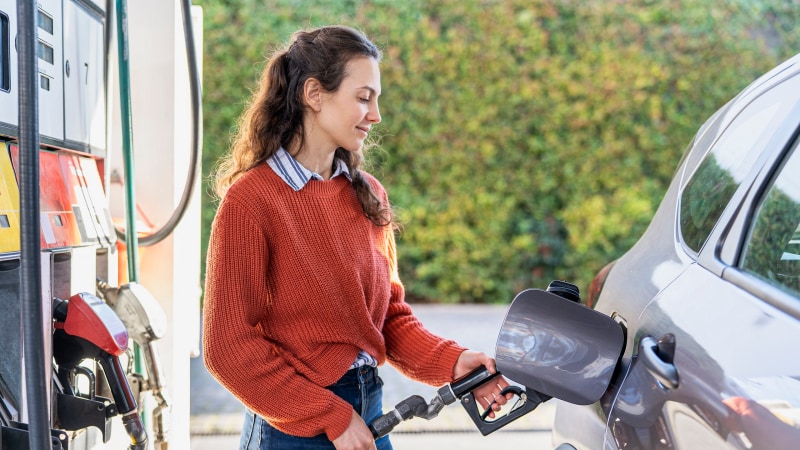How to help save money on gas

When reviewing your budget or spending habits, you may find that you're continually spending large amounts of money on gas. With ever fluctuating gas prices, knowing how to save money on gas can be great for your wallet. A few tips and tricks, such as maintaining your vehicle, can help save some money at the pump.
Tips for saving money on gas at the pump
When you pull into a gas station you'll likely notice that the sign has separate prices for cash and card, with the cash price usually coming in cheaper. This is because merchants are charged a processing fee when cards are used. Using cash helps the business avoid that fee, and the gas station passes those savings along to you.
While it may not seem like a huge difference, those extra cents a gallon add up over time, especially if you're filling up often for a long commute. You may want to make stopping at your bank or an ATM part of your weekly routine to ensure you always have cash on hand, as it's an easy way to save money on gas.
Some grocery stores also have gas rewards programs. Several major national chains have their own pumps in front of the store, and when you accumulate points for buying groceries they can be redeemed for cents off the gallon at the pump.
Many gas stations also offer their own rewards programs. These programs are generally free, but make sure you double check before signing up. For most gas stations, once you're a member you can use your rewards card at the pump to get the member price, which will save you some cents on the gallon. However, some work more like the grocery rewards programs, in which you build up points over time to redeem for cents off the gallon.
Credit cards with cash back benefits can also help. A card like the Chase Freedom Unlimited® offers 1.5% cash back on all purchases, meaning you'll be able to recoup a percentage of the money you spent by redeeming points earned by paying for gas.
There is no single best way to save money on gas, but paying in cash and using rewards programs to your advantage can help.
Tips for using less gas
Saving money on gas can also be achieved through simply using less gas. One way to do that is to remove extra weight from your car. Maybe this is a leftover moving box in your trunk or a bike rack strapped to the back during the winter months. Whatever it is, removing it can help your car use less gas.
Planning your routes can also help you save on gas. When you're driving somewhere, try to find the most fuel-efficient route (there are apps that can help with this). Also, if you know you'll have errands during the week, plan to hit the stores all at once. This can help reduce the frequency of individual drives and allows you to plan more fuel-efficient trips. Cars also run slightly more efficiently when they're already warm.
Alternatives to driving
Perhaps the easiest way to use less gas is by seeking out other modes of transportation. If you live only a couple of miles from work, consider biking there a few times a week instead of driving. Another option could be to carpool to work if you have a coworker who lives nearby. Not only does it cut down on the use of gas, but it may also allow access to carpool or high occupancy vehicle (HOV) lanes to bypass traffic.
Many cities provide publicly available electric scooters and bikes which could be another alternative to driving. Additionally, if you aren't already familiar with your local public transportation system, check out the routes online. You may be surprised that even in smaller cities and towns there are bus routes that will take you to shops, grocery stores, restaurants and pretty much anywhere else you need to go.
Driving tips
Perhaps an unexpected way to use less gas is through your driving habits. For instance, as you approach a red light, begin your braking earlier by taking your foot off the gas to more slowly come to a stop, rather than maintaining your speed and then braking hard at the last minute. Hard stops and starts generally use more energy than decelerating slowly and coasting to a stop.
Another tip is to use your cruise control wisely. When you're driving long stretches of uninterrupted miles, cruise control will help your car use less gas by maintaining a steady speed. Of course, this is not helpful in stop-and-go situations, so if you're driving through town or stuck in traffic, it's probably best to turn it off.
If you can help it, idling less is also good for using less gas. If you know you're going to be waiting in the car for a while, turning off your car is much more efficient than leaving it running. Of course, be mindful of the temperature. No fuel savings are worth unsafe conditions if you can't sit comfortably without heat or air conditioning.
Maintain your vehicle
Keeping your vehicle maintained can also help you with saving money on gas. Tire pressure is just one of the things that can affect your car's gas mileage. For those in climates with extreme temperature fluctuations throughout the year, you may notice that your tire pressure sensor light comes on after the first real cold snap of the year. When that happens, head to a gas station and fill up those tires (air is free at some places!). Keeping your tires at the proper PSI can help with your mileage.
It's also important to maintain your engine. Flip through your owner's manual and make sure you've been using the recommended motor oil — this will contribute to better engine health and performance. And if you notice the check engine light turn on, head to a shop and get it examined.
What's more
It can be hard to figure out how to save money on gas, especially when driving is often unavoidable for many people. However, by doing things like taking advantage of rewards programs, driving smart and maintaining your vehicle, you may just find some savings at the pump.



